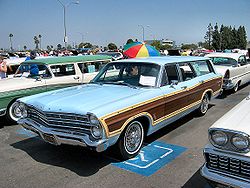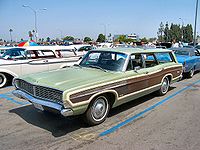
Ford Country Squire
Encyclopedia
Third generation
Prior to 1961, all Ford wagons used a two-piece tailgate assembly that required the operator to lift the rear window up and locking it into place via a mechanical support, and then drop the tail gate down to fully access the rear compartment.For the 1961 Ford adopted a tailgate assembly that used a self-storing window feature which could either be rolled down into the gate via crank on the outside of the gate, or by an electrical motor actuated by the key or an interior switch. A safety lockout measure required that the rear window had to be fully retracted into the tailgate before the tailgate could be lowered
Fourth generation (1965–1968)
In 1966, all Ford wagons introduced the Magic Door Gate, engineered by Donald N. FreyDonald N. Frey
Donald Nelson Frey , was widely known as the Ford Motor Company product manager who, along with Lee Iacocca and others, developed the Ford Mustang into a viable project — and who ultimately supervised the development of the car in a record 18 months.At times besieged by autograph seekers for...
, which allowed the tailgate to flip down like a traditional tailgate or to open to the side as a swinging door. The Magic Door Gate was made possible through use of a traditional stationary hinge on the right, and combination of hinges along the door's left side which carried the weight of the gate as it swung outward when used as a door.


Fifth generation (1969–1972)
The fifth generation Ford Country Squire (1969–1972) rode on an expanded 121 inches (3,073.4 mm) wheelbase as compared to the previous generation and included as standard a 302-cubic-inch V8. In mid 1969, the 302 cubic-inch standard engine was phased out in favor of a new standard engine, the 351 cubic-inch V8. Optional engines included the 390 cubic-inch or the 429 cubic-inch V8. In 1971, Ford offered 400 cubic-inch V8 as an option. Country Squires from 1969 and 1970 used the same body panels and varied in terms of front grille and bumper, interior trim and other minor changes. The later two years of this generation saw an extensive revision of the exterior, having only the roof and tailgate in common with the 1969-1970 models. This generation was the first to use Ford's new "Three-Way Magic Doorgate," which could swing down as a tailgate, swing out as a door with the window down, or swing out as a door with the window up (not possible with 1966-1968 wagons).Production figures:
- 1969: 129,235
- 1970: 108,914
- 1971: 130,644
- 1972: 121,419
Sixth generation (1973–1978)
For 1973, the platform used by full-size Fords and Mercurys was redesigned and lengthened even more; the addition of 5-mph bumpers front and rear would make these the longest station wagons ever produced by Ford. Unlike its LTD sedan counterpart, the Country Squire originally came only with the 400 and 460 cubic-inch V8s, later adding the 351 Windsor engine. In 1975, Ford added hidden headlamps to the Country Squire (bringing it in line with the Mercury Colony Park and Grand Marquis); exposed headlamps were still fitted to LTD-trim wagonsSeventh generation (1979–1991)
In 1979, Ford became the last American automaker to downsize its full-size car lines; the Panther platform became the basis for all full-size Fords, Mercurys, and Lincolns. Eleven inches shorter and nearly 1000 pounds lighter, the redesigned Country Squire retained the 8-passenger seating capability with only slightly reduced cargo capacity. The big-block 400 and 460 cubic-inch V8s were not included in the redesign, leaving the Country Squire with the 302 and 351 cubic-inch V8sV8 engine
A V8 engine is a V engine with eight cylinders mounted on the crankcase in two banks of four cylinders, in most cases set at a right angle to each other but sometimes at a narrower angle, with all eight pistons driving a common crankshaft....
; unlike General Motors station wagons, no six-cylinder or diesel engines were offered.
The 1980s saw relatively few changes to the Country Squire. In 1988, coinciding with the facelift of its LTD Crown Victoria counterpart, the Country Squire received a new front clip. Inside, new front seats with larger head restraints were added. For 1990, the dashboard was updated (for the first time since 1979) with the addition of a driver's side airbag; the outboard rear seats received 3-point seatbelts.
Discontinuation
After the mid-1980s introduction of minivanMinivan
Minivan is a type of van designed for personal use. Minivans are typically either two-box or one box designs for maximum interior volume – and are taller than a sedan, hatchback, or a station wagon....
s by Chrysler, Ford, and GM, sales of full-size station wagons began to decline. The primary behind the popularity of minivans were their superior cargo capacity and fuel economy despite taking up less garage space; by 1990, Ford's Aerostar
Ford Aerostar
The Ford Aerostar is a minivan produced by Ford Motor Company for the North American market; the first such design by Ford, it was sold from the 1986 to the 1997 model years. It was sold in both passenger van and cargo van configurations in two body lengths with both rear wheel drive and all wheel...
had overtaken all competitors in sales with the exception of the Chrysler minivans. Although Ford redesigned the Crown Victoria and Grand Marquis in 1992, the station wagon bodystyle was discontinued. In addition, a 1992 full-size Ford wagon would have likely competed against the wagon version of the Ford Taurus, then on its way to becoming the best-selling car in the United States.
Unique options and features
With certain versions of the Country Squire one could install an AM/FM-Cassette stereo with a combined and fully integrated Citizens' Band (CB) two-way radio, and replacement dual-purpose automatic antenna (with only one visible difference that the aerial mast was a larger diameter, and black-band at approximately half-way up). The radio would then have the appearance of an original equipment, factory radio.Optional were opposing side-facing rear seats, which could be folded down to make a durable cargo surface. Available for use with the side-facing rear seats was a folding table with integrated magnetic checkers board. Magnets under the plastic checkers pieces would keep them from sliding on the board while the vehicle was in motion.
Behind a rear fender well was a hidden, lockable compartment, not visible when the rear seat back was in the upright position.
GM
General Motors
General Motors Company , commonly known as GM, formerly incorporated as General Motors Corporation, is an American multinational automotive corporation headquartered in Detroit, Michigan and the world's second-largest automaker in 2010...
, Chrysler
Chrysler
Chrysler Group LLC is a multinational automaker headquartered in Auburn Hills, Michigan, USA. Chrysler was first organized as the Chrysler Corporation in 1925....
and AMC would adopt a similar configuration by the end of the 1960s. An advanced version of this was the 3-way tailgate
3-way tailgate
A 3-way tailgate is a tailgate on a station wagon than can be opened in the following three ways:# Sideways like a car door# Downwards like a truck tailgate# Open the window only to load small items...
which permitted opening the door sideways with the window up.
External links
- Smithsonian Instution 1955 Ford Country Squire in the Smithsonian Automobile Collection
- lovefords.org Website featuring a 1963 Ford LTD Country Squire
- LTDworld.com Website featuring a 1975 Ford LTD Country Squire
- Grandmarq.net Forum dedicated to the Ford, Lincoln, and Mercury Panther Chassis
- Ford Country Squire in television and film

